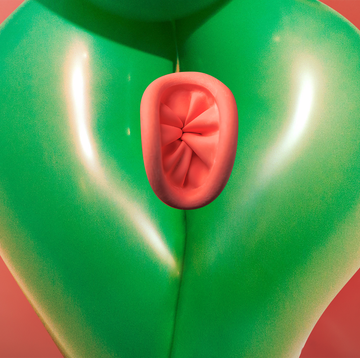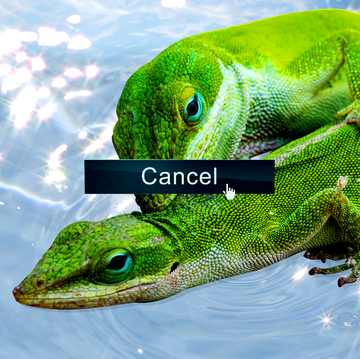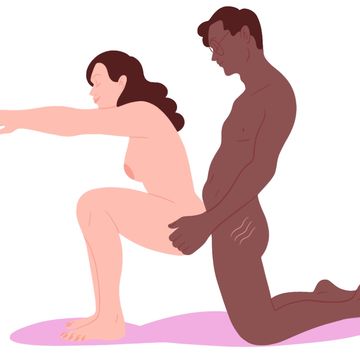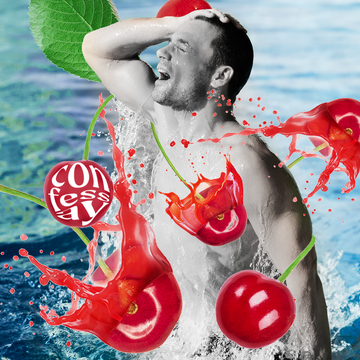Growing up in the early 2000s, I was obsessed with rom-coms. I studied them thoroughly, taking mental notes about how to play it cool, flirt, and most importantly, what finally having sex would be like IRL. While I would later come to learn that movies are, er, extremely unreliable sources of information, it was already too late. What I saw on-screen became the backbone of how I thought sex worked.
Among the long list of ill-advised expectations rom-coms created for me was one that led me to spend the majority of my adult life thus far believing there was something seriously wrong with me: the scene when the two main characters gaze into each other's eyes, and within seconds, start making out and having sex—on a table, in an elevator, in a car…you get it. Wherever they are, no matter the circumstances, both parties are always mentally and physically ready, with no foreplay whatsoever.
“It’s in every movie, romance novel, or sexualized commercial,” says queer sex educator Whitni Miller, a pleasure coach who specializes in desire discrepancy. “We are sold the idea that if you don't want sex just by thinking of it for two seconds, then you must be frigid or broken.”
More From Cosmopolitan

There’s actually a name for that immediate lust we see on screen: spontaneous desire, and it really is how some people experience sex and lust. Desire comes seemingly out of nowhere, or from just the thought of sex. But according to a study published in 2010 in The Journal Of Sex Medicine, for 30-50 percent of women, desire works differently. It appears after you’ve started having sex, and it’s known as responsive desire—when your mental “wanting” for it emerges in response to pleasure, explains sex educator and author Emily Nagoski, PhD, whether that’s playing with toys, oral sex, fingering, or in some cases, even penetration.
Understanding Responsive Desire.
Responsive desire isn’t the same thing as needing foreplay to get turned on, which is typically what pretty much everyone needs before sex. The activities that people consider foreplay (like kissing, touching, groping, etc.) are meant to build arousal, aka, what physically prepares your body for sex. Think: getting wet, expanding and softening the vaginal walls, or getting hard. Responsive desire is about the mental yearning for sex—the wanting of it all. When people engage in foreplay, it’s usually because they already feel desire. People who experience responsive desire typically need to try specific sexual activities, including foreplay, in order to actually want those activities to follow.
Experiencing responsive desire might not sound like that big of a deal, but it was eating me alive. “For many years, the standard model of sexual response said that desire comes first. The absence of spontaneous desire was considered a problem,” says Nagoski. And man, did I feel like a problem.
In college, I spent so much time wondering what was wrong with me, why sex didn’t randomly cross my mind throughout the day, or why I couldn’t go to parties, spot someone hot, get turned on, and then hook up like everyone else. I rarely had sex because I rarely felt desire. Eventually, I started avoiding it altogether. I became overwhelmed with concerns about why I didn’t want to have it when I gazed into my crush’s eyes. How could I be a good sexual partner if I couldn’t get turned on when my partner did? How would I be desirable if I didn’t have a desire for sex? What would it mean if I could never fix this?
Feeling so different from my friends, from every person I had been with, and from every depiction of sex I had ever seen made me think I had female sexual arousal disorder— a sexual dysfunction characterized by a lack of interest in sex. At the time, this self-diagnosis made me feel slightly relieved. It was nice to know that other people were going through the same thing. But even still, my shame convinced me that I should be trying to “fix” whatever was “wrong” with me. And when you believe that you’re broken and need to be fixed, it’s easy to feel pretty damn bad about yourself. Any remaining shred of sexual confidence I had quickly evaporated.
Learning About Responsive Desire Helped Me Realize I Wasn't Broken, Just Different.
It wasn’t until I graduated, took a year-and-a-half-long hiatus from partnered sex, and took a deep look at my sexuality that I realized I might not have a sexual dysfunction after all. I started doing my own online research and eventually stumbled on Nagoski’s TED Talk from 2018. For the first time, I felt seen, which prompted me to read her book, Come As You Are, all about the science of sexual desire. Slowly but surely, my body and my sexuality started to make sense.
I learned that for many people, desiring sex is far more complex than taking one look at someone you find attractive, even if they’re someone you love. Responsive desire isn’t uncommon—many women need sexual stimuli (anything your brain codes as sex-related), and sometimes, a significant amount of it, to thoroughly enjoy that stimulus and want to go further. For me, this meant that I wouldn’t feel that burning desire until far into the sex itself.
I also learned that upbringing can play a significant role. Growing up in a society that largely imparted religious beliefs about purity, I was taught that masturbation was shameful, that I had a duty to have sex with my partner, and that ultimately, sex wasn’t about my pleasure. All of these things made me feel overwhelmingly anxious, nervous, and uncomfortable about sex, which had an enormous impact on my ability to get turned on.
“Sex, and our desire to participate in it, is affected by our psychological landscape, including our mindset and past experiences,” explains Miller. “The programs in our society, such as shame from purity culture, fear of unwanted pregnancy, and performance anxiety, are all factors that affect whether we can get motivated for sex or not.”
The sexual experiences that I had etched in shame finally became clear. I didn’t have an arousal disorder, or low libido, nor was I “lacking” anything. I just experience a different type of desire. As I learned more about it, my sexual confidence started to come back. I started re-writing the narrative that I was “broken” and tried to remember that just because my desire was different from what I knew to be “normal,” that didn’t mean it was wrong.
The Confusing Relationship Between Responsive Desire and Enthusiastic Consent.
But it wasn’t an instant fix. Only wanting sex after I started having it didn’t fit into what I understood enthusiastic consent to be, which was only doing it when I was 100 percent sure that I wanted to. I didn’t want to feel like I was succumbing to pressure and not prioritizing my own needs every time I had sex, and I struggled to understand if choosing to have it when I was curious, but not positive, meant that I wasn’t giving consent. But at the same time, I knew that in order to get turned on, I needed pleasurable sexual stimulation for desire to follow. I didn’t see space in mainstream conversations about desire feeling somewhere between “fuck yes!” and “no thanks,” still going through with sex, and that being okay.
These days, there are new words being used in sex education to describe this spectrum of feelings: wanting and willing. “Wanting is actively desiring something,” says Nagoski. “Willing, by contrast, is being open to trying something without knowing for sure that it’ll be the right thing.”
For those who experience responsive desire, it’s common to feel open, or genuinely “willing” to try something to see how it feels, but not necessarily feeling enthusiastic about it quite yet. It might not be until you actually start doing something that feels really, really good that you feel more of a desire for it, and it’s important to communicate those boundaries to a trusted partner to ensure they respect your limits if you want to stop.
Since sex doesn’t cross my mind that often, I’ve learned that I need to set aside planned time for it. This can look like playing with a sex toy, listening to erotica, or watching porn on my own and seeing how it feels. If I like it, and I start wanting more of it, I’ll continue. If I feel open to it, I’ll ask my partner if they want to join me, and I’ll see how that feels. From there, we might try something else we’re both open to. For me, sex often unfolds in this way—not always actively wanting an aspect of it, whether it be a position or technique, until after I start doing it.
Understanding how responsive desire actually works, learning new strategies, and building skills to check-in and gauge my level of interest has helped me feel so much more empowered in my sexuality. I used to feel like anxiety, overwhelm, stress, and confusion controlled my sex life. Now that I'm confident in how my body works, I feel empowered to make decisions that make sense for me. Without the pressure of trying to “fix” my sex life, I can finally start enjoying it.
Ella Dorval Hall is an internationally acclaimed sexuality educator, writer, and coach. Trained in comprehensive sexuality education, Ella specializes in supporting clients who are struggling with desire, libido, and people-pleasing in the bedroom. In addition to Cosmopolitan, Ella’s work has been featured in Refinery29, mindbodygreen, Insider, Well + Good, The Everygirl, and more. You can follow their work on Instagram and LinkedIn.












